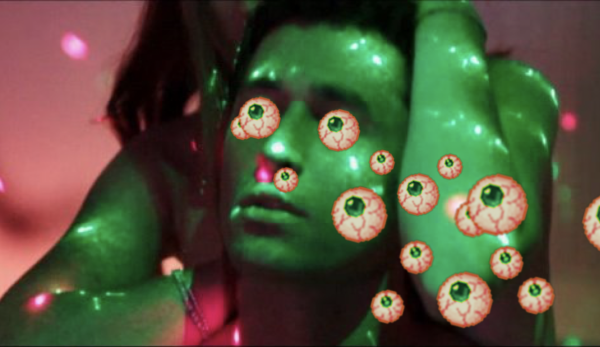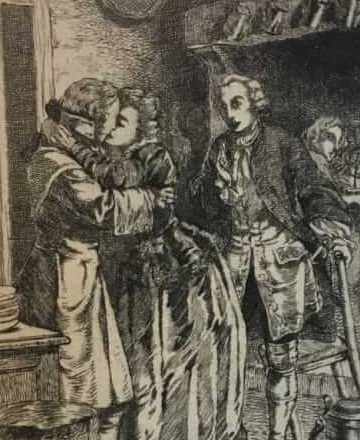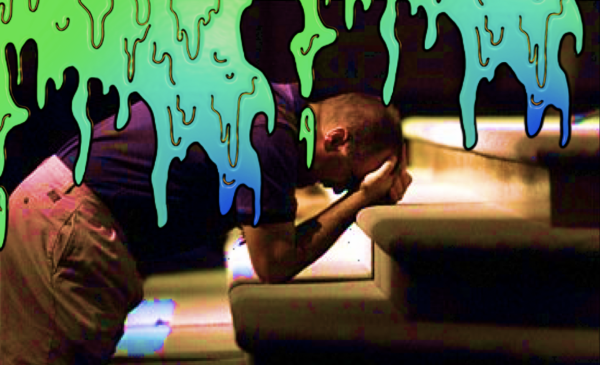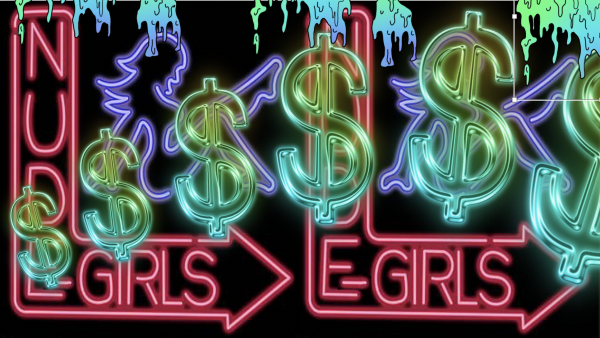Perversion can never be stripped of shame.
Obscenity Blindness

Pornographic technology has turned sensory overload into sensory degradation.
In 1949, the British research group Mass-Observation conducted a survey into English sex habits, which, among other questions, asked respondents how they had first become aware of sex.
About 20% said their parents had explained it to them.
Eight percent said they had learned it from a book, usually a medical textbook or a pamphlet on hygiene.
Fully a quarter said they had just “picked up” their sex knowledge. “Nobody taught me, they didn’t have to,” said a 52-year-old farmer from Tadcaster. “I had eyes in my head. Mind you, I’ve always lived on a farm.”
For anyone born since 1995, it is not necessary to ask how they became aware of sex. It was by watching PornHub on a friend’s smartphone at the age of 13.
It is hard to get a grip on the scale of the pornography problem because the social-scientific data is so unreliable. The report of the President’s Commission on Obscenity and Pornography, published in 1970, found that 60% of Americans believed “adults should be allowed to read or see any explicit sexual materials that they want to” but also that 73% thought gratuitous sex scenes in movies should “definitely not be allowed.”
If polls are that self-contradictory on what Americans think about pornography, it is hard to have trust in self-reported data on what they’re doing, whether a generation ago or today. The current recognized figure that 43% of men have watched pornography in the last week seems low.
People who want to minimize the porn problem insist that human beings aren’t any more dirty-minded today than they were 50 years ago, or 100, or 2,000. (Think of those Pompeii frescoes!)
It is true that people haven’t changed—but technology has.
An Unprecedented Revolution
Three changes in particular have made porn a bigger problem in the last decade than at any time in human history.
- Moving pictures. The most erotic writing pales next to a single image, and the most erotic image is less suggestive than a thirty second MP4. Video is a qualitatively different medium. Think of PTSD: You can imagine someone being traumatized by watching video of a disturbing event, but not just from being told about it.
- Privacy. Until around 1982, seeing a dirty movie meant going to a public place, like a porno theatre or a stag party hosted by someone who knew how to operate an 8mm film projector. In 1976, when Travis Bickle took Betsy on their ill-advised date to see Swedish Marriage Manual, there were only 800 porno theatres in the United States. With the advent of video, for the first time the experience of watching video pornography became private. A customer’s only moment of public vulnerability was when he bought the cassette from the video store, and mail order got around even that.
- Variety. Between 1988 and 2005—that is, the year before YouPorn went live—the number of porn videos produced each year increased by a factor of ten, from 1,300 to 13,000. The most recent year-in-review numbers from PornHub say that 1,360,000 hours of new material was uploaded to the site in 2019. “The first telegraph message was sent on May 24, 1844,” they explain jauntily. “If you started watching PornHub then, you would still be watching new videos today.”
Moving-picture pornography has been around for a little over a century. It has been available for private viewing for two generations. It has been instantly accessible in infinite variety on the computer in everyone’s pocket for only a decade. It is not an exaggeration to call the current situation unprecedented.
Some have compared online streaming pornography to high-calorie snacks, which our primitive instincts tell us to consume but which modern man had to learn to eat only in moderation after they started being mass-produced in the mid-twentieth century.
I would rate it more disruptive than that. Online streaming pornography is a revolution on par with the invention of the printing press.
Banal Intercourse
Everyone hated the movie The Canyons when it came out in 2013, which was fair insofar as Lindsay Lohan was between her 5th and 6th stints in rehab when they filmed it and director Paul Schrader got better acting out of his male lead, an actual porn star.
But far from being the trashy thriller it appeared, The Canyons was the culmination of Schrader’s career-long meditation on pornography in America. The three films in Schrader’s pornography triptych correspond to three eras of technology: Hardcore (1979), starring George C. Scott, depicts the age of film; Auto Focus (2002), starring Greg Kinnear as doomed Hogan’s Heroes actor Bob Crane, the age of video; The Canyons, the age of smartphones.
Hardcore is currently most famous for the reaction shot of George C. Scott watching a porn film starring his runaway daughter (“Turn it off!”), which, as a meme, has been adapted to as many different uses as the Downfall bunker rant. The point of historical interest for viewers of that scene is that, when the private detective wants to show Scott that film, he has to rent a theatre. Film required special training and equipment just to view, never mind shoot and develop.
The same was not true of video.
“It’s not like film. With video, there’s no processing,” Bob Crane’s partner in crime, played by Willem Dafoe, tells him in Auto Focus. “It’s like the Polaroid of home movies.” The point of Auto Focus is that the instant gratification of the home video porn cycle—pick up girls, record sex acts, watch tape, repeat—turns Bob Crane from an ordinary Hollywood horn-dog into a sex addict.
If you watch the trailer for Auto Focus, you will see Bob Crane telling his agent, who is worried about his client’s reputation, “Sex is normal, it’s good for you, I’m normal”—not very convincingly, with his five o’clock shadow and dirtbag aviators. Contrast this with what George C. Scott says to the Los Angeles hooker he picks up to help him find his daughter. “How important do you think sex is?” she asks him. “Not very,” he says. “Then we’re both alike,” she replies.
Ordinary civilians and professionals both keep sex in perspective. It’s the porn viewer, caught between the two, who becomes obsessive. The obsession only gets worse when the viewer himself becomes a content producer the way Bob Crane does. He suffers all the compulsiveness of unlimited supply with none of the detachment of a professional.
This toxic dynamic is accelerated to 3G speed in The Canyons, which was supposed to be James Deen’s breakthrough crossover from porn to Hollywood but ended up looking more like Lindsay Lohan’s crossover into porn. Three-ways, four-ways, oral sex, choking, Schrader films all of it—and so do the characters.
In the opening scene, James Deen tells his personal assistant that he won’t be going on location for the filming of a horror movie his company is producing because “I’ll be too busy making my own little movies.” The assistant’s naïve boyfriend asks what he means. “On this, dude,” Deen says, holding up his smartphone, and explains to him how Tinder works.
Bret Easton Ellis wrote the script for The Canyons, and it has his signature style of “beautiful people doing bad things in nice rooms” (Schrader’s pithy phrase), but everything that seemed so cool and sleek and glossy in the 1980s has become sterile and tawdry.
Our glamor couple doesn’t even throw parties like the one at the beginning of Less Than Zero. They find exactly as many people as they need for the evening on Tinder, and everybody gets naked within minutes of arriving. It’s more efficient, but how much sadder.
The Myth of the Sexpert
The awfulness depicted in The Canyons is of the Internet age, but the mistakes that made it possible started in the 1960s.
The phrase “utterly without redeeming social value,” crucial to the evolving legal definition of obscenity, originated in the 1960s. Its main purpose is to establish artistic value as a defense. “Well-written obscenity,” one First Amendment lawyer intoned at the time, “is a contradiction in terms.” Before then, artistic quality had been an aggravating factor for obscenity in many jurisdictions.
The eminent Cambridge philosopher Bernard Williams, who chaired Britain’s Committee on Obscenity and Film Censorship, thought this exception was the stupidest part of British obscenity law.
The committee’s final report in 1979 was mostly liberal in its recommendations, but one rule they recommended tightening was the exception for works of artistic or historical merit. If pornography was harmless (as Williams believed it was, as long as it was vanilla), then legalize it for that reason. If it was harmful (like a rape film), then any merits it might possess were irrelevant. Either way, we should dispense with the undignified spectacle of expert witnesses “trying to think of otherwise unknown facts about 18th century London which one might learn from Fanny Hill.”
The most famous such spectacle was the Chatterly trial, the fons et origo of the artistic value defense. There’s a reason it remains the most celebrated obscenity case today, and it’s not just because Philip Larkin namechecked it. Most obscenity has no artistic pretensions whatsoever, but by associating themselves with a distinguished novelist like D.H. Lawrence, pornographers can pretend that their expansive interpretation of the First Amendment is designed to protect great works of literature and not, as in the more consequential landmark case People v. Freeman (1988), the sodomy spectacular Come from Behind, Part II.
Curiously, one literary scholar who did not testify at the Chatterly trial was F. R. Leavis, the most eminent critic in England and also the man most responsible for establishing Lawrence’s reputation back in the 1930s when it was more fashionable to dismiss Lawrence as a coal country barbarian. Leavis defended Lawrence against sneering attacks from T.S. Eliot and Bertrand Russell, but he would not defend Lady Chatterly’s Lover at the Old Bailey. His silence was deafening, but because other English professors were found to testify, the jury did not hear it.
It did not take long after the advent of “redeeming social or literary value” as a defense in the Chatterly trials—decided in most Anglosphere countries between 1959 and 1962—for it to become clear that the rule was infinitely elastic. It starts by making an exception for D.H. Lawrence and ends up covering everything short of a snuff film.
One California prosecutor told an interviewer in 1977 about a case he tried against a hardcore fisting film. “We had pathologists testify that the person would have to be under some kind of drugs or sedatives.” The jury nevertheless returned an acquittal because, as the foreman told the prosecutor, “It had educational value in that it instructed me not to engage in this form of activity.”
Worse than the rule’s flexibility was its introduction of experts into the courtroom.
Before “utterly without redeeming social value” became the standard for obscenity, no expert witness would ever have been called to testify to a book or film’s artistic merit because the question would have been irrelevant. But by 1966, the U.S. Supreme Court was overturning the Massachusetts obscenity conviction of Fanny Hill primarily because professors from Harvard, Williams, and Brandeis told them to.
There was only one expert witness for the prosecution in that case, the headmaster of a prep school who formerly taught English at Boston Latin.
Whose expertise should have counted for more?
I would have said the headmaster, since he taught students closer to puberty whose sexual habits were still developing and therefore knew more about the effects of pornography on young libidos. But Justice Brennan thought that the ability to situate John Cleland in the tradition of 18th-century epistolary fiction was more important.
Really the whole question is misbegotten, because the kind of “expertise” the Supreme Court wanted to rely on doesn’t exist.
Our legal definition of obscenity relies on expert witnesses, but there is no such thing as an expert in sex. Who has sounder judgment, a prostitute or a Catholic priest? A spinster Harlequin writer or a mother of five?
Sex is the kind of thing where constant exposure is more likely to warp a person’s perception than sharpen it. One can be wise on the subject of sex, but not expert.
Media Can Hurt You
Of all the people to be wise on the subject of sex, Paul Schrader is not one anybody would have predicted.
He grew up among the strict Dutch Calvinists of Grand Rapids, who don’t loom large in the American imagination because they haven’t produced very many creative artists, but suffice it to say that if we did have artistic representations of growing up Dutch in Grand Rapids, we would stop thinking of Boston Irish Catholics as our gold standard of uptightness.
Schrader’s parents were so strict that he didn’t see any movies, never mind dirty movies, until he snuck into Disney’s The Absent-Minded Professor when he was 17. It is therefore strange that he should have made so many thoughtful films about pornography. He had to fight to convince his family and his own Dutch Calvinist conscience that moviemaking was an honorable career.
You’d think he’d want to avoid thinking about the sort of movies that confirm their worst suspicions.
But in a way it makes sense. Most of us grew up adhering to the standard liberal articles of faith about freedom of speech: mere words and images can’t hurt us; the cure for bad speech is more speech; censorship offends the dignity of man. Porn is an exception that we don’t like to think about because it makes our brains flash “Does Not Compute.”
Schrader, on the other hand, grew up knowing that media can hurt you, so porn was never a brain-scrambling exception to him.
The films he watched as a teenager, even benign ones about Fred MacMurray and Flubber, really did erode his attachment to his parent’s faith and culture, even though that wasn’t his intention when he went to see them. He and his parents grew apart but they have always agreed on one thing: what we see and hear can affect us for the worse even if we come into the theatre girded with a sturdy Calvinist conscience.
If a book persuades a man to believe falsehoods, he can be persuaded back around to the truth; if a movie degrades a man’s senses, there’s no way for it to be undone. This is true of all degrading media, from trashy celebrity gossip to the Saw franchise. Porn is not a special case, just an extreme one.
There are two obstacles standing in the way of action on pornography today. The first is technological. Solutions exist for that one. The other is cultural, our willingness to try.
We have been too blinded by patently false ideas that no one before the Sixties ever believed—that artistic expression justifies obscenity, that pornography’s effect on the soul is as reversible as a false argument’s effect on the brain—and it has made us reluctant.
An easy cure for that reluctance would be to watch the first 20 minutes of The Canyons.
The American Mind presents a range of perspectives. Views are writers’ own and do not necessarily represent those of The Claremont Institute.
The American Mind is a publication of the Claremont Institute, a non-profit 501(c)(3) organization, dedicated to restoring the principles of the American Founding to their rightful, preeminent authority in our national life. Interested in supporting our work? Gifts to the Claremont Institute are tax-deductible.
Aristotle points the way to true virtue through free will.
The case of pornography.
The American people have become acolytes of a religion of the flesh.
How to find our way out from our culture-wide sex addiction.
Talk of the free market is laughable when it comes to porn.






